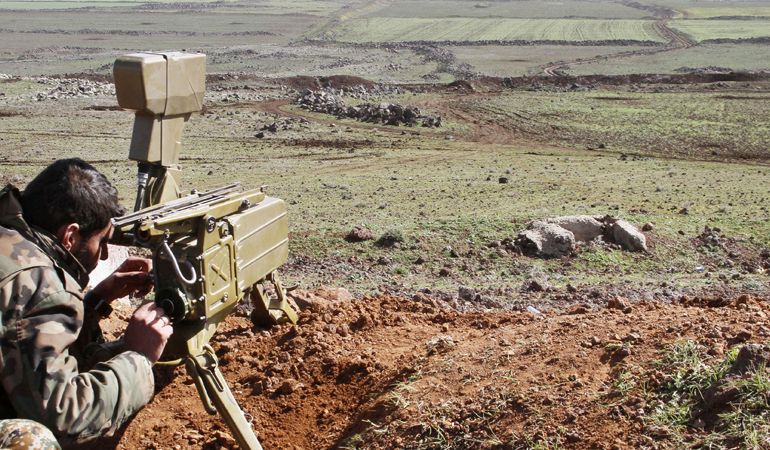Analysis: Syria’s chessboard politics
The lesson learnt from the Syrian crisis four years on is that all regional events are interconnected.

“Small wars can have big consequences”, wrote Rashid Khalidi in his forward to the 2007 “War on Lebanon: A Reader.”
This statement specifically addresses the regional implications of Israel’s 2006 war on Lebanon, as it illuminates a basic geopolitical rule that dictated the politics of the region since the end of the cold war: All regional events are interconnected, and all local events, therefore, by implication and necessity, are regional and international.
In both Egypt and Syria, the epicentres of the Arab homeland, the recent unfolding of events is a good example of this Middle Eastern chessboard politics, whose basic rule is now well known to every geopolitical analyst, as to any seasoned chess player: It is “the importance of difference” as Swiss linguist Ferdinand de Saussure put it.
To move a single piece is to alter and to reconfigure the whole meaning and structure of the game altogether. Does this explain, in part at least, what has been unfolding in Syria recently? Lets recount.
OPINION: This is how we failed Syria
On February 12, 2012, Vita Bekker of Israel’s Institute for National Security Studies (INSS) wrote that Israel was worried about a potential regime change in Egypt during the Egyptian revolution. This fact, however, was very well known as early as February 7, 2011, when a Wikileaks document released by The Telegraph revealed that Israel had established a “secret hotline to the man tipped to replace Mubarak”. Omar Suleiman was “named as Israel’s preferred candidate for the job after discussions with American officials in 2008”.
But, on January 25, 2011, the revolution disturbed the plan. Israel was worried.
In contrast to Egypt, Bekker reported on Syria the following: “Israel does not fear a regime change in Syria,” reminding the readers of a statement made by Israel’s minister of war, Moshe Yaalon in February 2012 to a radio station: “Mr Assad’s ouster could be good for Israel, spurring ‘a fissure in the Tehran-Damascus-Beirut-Hamas axis of evil’.”
|
|
In the same INSS report, Ehud Barak, one of Israel’s foremost strategists, who predicted in mid-December 2011 that Assad would lose power “within a few weeks”, added “his downfall would be a blessing for the Middle East”.
But Assad did not fall, and three years later, on April 26, 2014, Benedetta Berti, also of Israel’s INSS wrote: “Syria alters Israel-Hezbollah dynamics.” Syria, as it would become clear later, has been an open and bloody site of direct and indirect confrontation between various regional axes and international powers – despite, or in spite of, the continuous revolutionary lingo uttered by various armed groups and the humanitarian discourse that dictated the media coverage.
Israel’s unprovoked attack on a Hezbollah group in Syria Golan’s Quneitra on January 18, and Hezbollah’s retaliation in Shabaa Farms in Southern Lebanon on January 28, signified the nature of the crisis as much as it changed the rules of engagement. Israel is now directly involved in the Syrian crisis, not by proxy as earlier reports indicated.
Israel’s I24 News confirmed on November 10, 2014, that “some members of al-Nusra and ISIL are hospitalised in Israel” (al-Nusra is of course the al-Qaeda branch in Syria, while ISIL is its infamous sister).
OPINION: Syria is dead, long live the Syrians
No Israeli denial was made, rather Israel’s military spokesman’s office confirmed to I24 News what they called “engagement in humanitarian, life-saving aid to wounded Syrians”. But Israel is not the only regional or international power that is involved in the Syrian crisis.
In what it called an exclusive, the Daily Beast reported the following on January 27: “Obama cuts off Syrian rebels’ cash”. The financial and the so-called “nonlethal” aid to insurgents might have been known for a while, but a November 2014 story revealed a different and more serious US intervention. The Telegraph, as well as various other media outlets, reported about al-Nusra Front’s possession of the advanced TOW American anti-tank missiles. They had captured them earlier from Hazm movement (a Muslim Brotherhood militia) and the Syrian Revolutionary Front that the US supported.
But, before even considering the potential reasons for why the US would support any armed group in Syria, one might want to read what The Washington Post reported on January 5, under the heading: “The rise and ugly fall of a moderate Syrian rebel offers lessons for the West.”
Jamal Maarouf, the subject of the report, seems to embody the story of many Syrian armed opposition groups. Maarouf, described in the article as “warlord” was sponsored by “Saudi Arabia, a US ally, which saw in him an opportunity to push back against the rising influence of Islamist groups”.
As the fourth year of the crisis comes to an end, the regional and international involvement in the Syrian crisis intensifies. It is not possible to name a single Syrian armed opposition group without a regional or international connection. The war in, and on, Syria is, therefore, a bloody exercise in geopolitics and regional reconfiguration. Why? Look at the map.
But as regional and international powers play their bloody chess game, and as the repositioning of various members of the regional axes continues, Syria and the Syrian people continue to bleed. Our hearts continue to ache.
Seif Dana is a professor of sociology at the University of Wisconsin-Parkside.